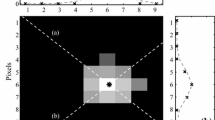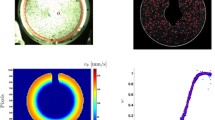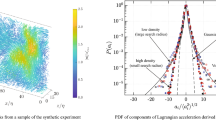Abstract
The granular temperature is an index of the level of collisional activity in a granular flow, and increasingly important in the verification of extended kinetic theories. The granular temperature is related to the square of the difference between a particle’s velocity and that of the group mean. Image analysis of high-speed video is the most common method to measure granular temperature in experimental flows and depends on correlation of a search mask or a portion of the original image to the next image frame to determine the particle’s movement. This invariably involves some level of estimation of the location at a resolution finer than the pixels that make up the image. However, errors in determining particle movement at the subpixel level can be shown to have a significant impact on granular temperature identification. We show that taking particle movement to be a chain of displacement vectors provides context to the apparent impulses on the particle. Here we propose two novel methods for determining the granular temperature of experimental flows, namely a novel method of initializing Particle Image Velocimetry (PIV) for granular systems where each search subset is centred on a previously determined particle location to reduce bias, and a method of filtering the apparent impulses on a particle on a frequency basis. We term these methods Guided-PIV and Impulse Frequency Filtering (IFF), respectively. In a verification exercise using synthetically generated images, we show Guided-PIV to produce substantially more accurate results than ordinary applications of PIV. The IFF method is shown to greatly reduce the influence of analyzed framerate on granular temperature results. Our results demonstrate practical improvements for granular temperature identification from image analysis, throughout a range of experimental image quality levels, and we anticipate that these improvements will enable experimental assessment towards verification of theorized models of collisional-frictional granular flows.











Similar content being viewed by others
References
Armanini, A.: Granular flows driven by gravity. J. Hydraul. Res. 51(2), 111 (2013). https://doi.org/10.1080/00221686.2013.788080
Bagnold, R.: Experiments on a gravity-free dispersion of large solid spheres in a Newtonian fluid under shear. Proc. R. Soc. London Ser. A Math. Phys. Sci. 225(1160), 49 (1954). https://doi.org/10.1098/rspa.1954.0186
Ogawa, S.: In: Cowin, S., Satake, M., (eds) Proceedings of the US-Japan Seminar on Continuum-Mechanical and Statistical Approaches in the Mechanics of Granular Materials, pp. 208–217. Gakujutsu Bunken Fukyukai, Tokyo (1978)
Lun, C.K.K., Savage, S.B.: The effects of an impact velocity dependent coefficient of restitution on stresses developed by sheared granular materials. Acta Mech. 63(1–4), 15 (1986). https://doi.org/10.1007/bf01182538
Jenkins, J.T.: Dense inclined flows of inelastic spheres. Granul. Matter 10(1), 47 (2007). https://doi.org/10.1007/s10035-007-0057-z
Haff, P.K.: Grain flow as a fluid-mechanical phenomenon. J. Fluid Mech. 134(1), 401 (1983). https://doi.org/10.1017/s0022112083003419
Capart, H., Young, D.L., Zech, Y.: Voronoï imaging methods for the measurement of granular flows. Exp. Fluids 32(1), 121 (2002). https://doi.org/10.1007/s003480200013
Reis, P.M., Ingale, R.A., Shattuck, M.D.: Forcing independent velocity distributions in an experimental granular fluid. Phys. Rev. E 75, 5 (2007). https://doi.org/10.1103/physreve.75.051311
Hsiau, S., Lu, L., Tai, C.: Experimental investigations of granular temperature in vertical vibrated beds. Powder Technol. 182(2), 202 (2008). https://doi.org/10.1016/j.powtec.2007.09.015
Seguin, A., Bertho, Y., Martinez, F., Crassous, J., Gondret, P.: Experimental velocity fields and forces for a cylinder penetrating into a granular medium. Phys. Rev. E 87, 1 (2013). https://doi.org/10.1103/physreve.87.012201
Sanvitale, N., Bowman, E.T.: Using PIV to measure granular temperature in saturated unsteady polydisperse granular flows. Granul. Matter 18(3), 57 (2016). https://doi.org/10.1007/s10035-016-0620-6
Maranic, Z., Guillard, F., Baker, J., Einav, I., Marks, B.: A granular thermometer. Granul. Matter 23, 2 (2021). https://doi.org/10.1007/s10035-020-01081-3
Gollin, D., Brevis, W., Bowman, E.T., Shepley, P.: Performance of PIV and PTV for granular flow measurements. Granul. Matter 19, 3 (2017). https://doi.org/10.1007/s10035-017-0730-9
Murray, C.A., Hoult, N.A., Take, W.A.: Dynamic measurements using digital image correlation. Int. J. Phys. Model. Geotech. 17(1), 41 (2017). https://doi.org/10.1680/jphmg.15.00055
Goldhirsch, I.: Introduction to granular temperature. Powder Technol. 182(2), 130 (2008). https://doi.org/10.1016/j.powtec.2007.12.002
Sarno, L., Carleo, L., Papa, M.N., Villani, P.: Experimental investigation on the effects of the fixed boundaries in channelized dry granular flows. Rock Mech. Rock Eng. 51(1), 203 (2017). https://doi.org/10.1007/s00603-017-1311-2
Jesuthasan, N., Baliga, B.R., Savage, S.B.: Use of particle tracking velocimetry for measurements of granular flows: review and application. KONA Powder Part. J. 24, 15 (2006). https://doi.org/10.14356/kona.2006006
Takehara, K., Etoh, T.: A study on particle identification in PTV particle mask correlation method. J. Vis. 1(3), 313 (1999). https://doi.org/10.1007/bf03181412
Perez, C.E.E.: Analysis, Comparison and Modification of Various Particle Image Velocimetry (PIV) Algorithms, Master’s thesis. Texas A&M University, Texas (2004)
Brevis, W., Niño, Y., Jirka, G.H.: Integrating cross-correlation and relaxation algorithms for particle tracking velocimetry. Exp. Fluids 50(1), 135 (2010). https://doi.org/10.1007/s00348-010-0907-z
Thielicke, W., Stamhuis, E.J.: PIVlab - towards user-friendly, affordable and accurate digital particle image velocimetry in MATLAB. J. Open Res Softw. (2014). https://doi.org/10.5334/jors.bl
White, D.J., Take, W.A., Bolton, M.D.: Soil deformation measurement using particle image velocimetry (PIV) and photogrammetry. Géotechnique 53(7), 619 (2003). https://doi.org/10.1680/geot.2003.53.7.619
Adrian, R.J., Westerweel, J.: Particle image velocimetry. Cambridge University Press, Cambridge (2011)
Keane, R.D., Adrian, R.J.: Theory of cross-correlation analysis of PIV images. Appl. Sci. Res. 49(3), 191 (1992). https://doi.org/10.1007/bf00384623
Reynolds, G.K., Nilpawar, A.M., Salman, A.D., Hounslow, M.J.: Direct measurement of surface granular temperature in a high shear granulator. Powder Technol. 182(2), 211 (2008). https://doi.org/10.1016/j.powtec.2007.11.034
Sanvitale, N., Bowman, E.T.: Visualization of dominant stress-transfer mechanisms in experimental debris flows of different particle-size distribution. Can. Geotech. J. 54(2), 258 (2017). https://doi.org/10.1139/cgj-2015-0532
Sarno, L., Carravetta, A., Tai, Y.C., Martino, R., Papa, M.N., Kuo, C.Y.: Measuring the velocity fields of granular flows – employment of a multi-pass two-dimensional particle image velocimetry (2D-PIV) approach. Adv. Powder Technol. 29(12), 3107 (2018). https://doi.org/10.1016/j.apt.2018.08.014
Hart, D.P.: Super-resolution PIV by recursive local-correlation. J. Vis. 3(2), 187 (2000). https://doi.org/10.1007/bf03182411
White, D.J., Take, W.A.: GeoPIV: particle image velocimetry (PIV) software for use in geotechnical testing. Technical Report. Cambridge University Department of Engineering, Cambridge, UK (2002)
Stanier, S.A., Blaber, J., Take, W.A., White, D.J.: Improved image-based deformation measurement for geotechnical applications. Can. Geotech. J. 53(5), 727 (2016). https://doi.org/10.1139/cgj-2015-0253
Cowen, E.A., Monismith, S.G.: A hybrid digital particle tracking velocimetry technique. Exp. Fluids 22(3), 199 (1997). https://doi.org/10.1007/s003480050038
Weinhart, T., Orefice, L., Post, M., van Schrojenstein Lantman, M.P., Denissen, I.F.C., Tunuguntla, D.R., Tsang, J.M.F., Cheng, H., Shaheen, M.Y., Shi, H., Rapino, P., Grannonio, E., Losacco, N., Barbosa, J., Jing, L., Naranjo, J.E.A., Roy, S., den Otter, W.K., Thornton, A.R.: Fast, flexible particle simulations — an introduction to MercuryDPM. Comput. Phys. Commun. 249, 107129 (2020). https://doi.org/10.1016/j.cpc.2019.107129
MercuryDPM. http://www.mercurydpm.org
Gollin, D., Berzi, D., Bowman, E.T.: Extended kinetic theory applied to inclined granular flows: role of boundaries. Granul. Matter 19, 3 (2017). https://doi.org/10.1007/s10035-017-0738-1
Stanier, S., Dijkstra, J., Leśniewska, D., Hambleton, J., White, D., Wood, D.M.: Vermiculate artefacts in image analysis of granular materials. Comput. Geotech. 72, 100 (2016). https://doi.org/10.1016/j.compgeo.2015.11.013
Gollin, D.: An Investigation on the Collisional Behaviour of Granular Flows. University of Sheffield (2017). (Ph.D. thesis)
Sanvitale, N., Bowman, E.T.: Internal imaging of saturated granular free-surface flows. Int. J. Phys. Model. Geotech. 12(4), 129 (2012). https://doi.org/10.1680/ijpmg.12.00002
Acknowledgements
This project is the result of a Leverhulme Trust International Network Grant (#IN-2016-041) “The Rosetta Stone Network: Physical testing towards a common understanding of debris flows”. Funding for the first author was provided by a NSERC Discovery Grant to the last author. Funding for the second author was courtesy of the Engineering and Physical Sciences Research Council, UK via a Doctoral Training Award held at the University of Sheffield.
Author information
Authors and Affiliations
Corresponding author
Ethics declarations
Conflict of interest
The authors declare that they have no conflict of interest.
Additional information
Publisher's Note
Springer Nature remains neutral with regard to jurisdictional claims in published maps and institutional affiliations.
Supplementary Information
Below is the link to the electronic supplementary material.
Rights and permissions
About this article
Cite this article
Taylor-Noonan, A.M., Gollin, D., Bowman, E.T. et al. The influence of image analysis methodology on the calculation of granular temperature for granular flows. Granular Matter 23, 96 (2021). https://doi.org/10.1007/s10035-021-01153-y
Received:
Accepted:
Published:
DOI: https://doi.org/10.1007/s10035-021-01153-y




